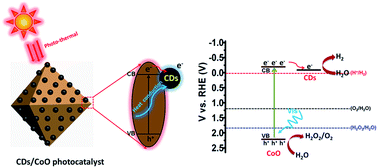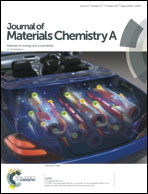Carbon dots anchored on octahedral CoO as a stable visible-light-responsive composite photocatalyst for overall water splitting†
Abstract
Photocatalytic overall water splitting using particulate semiconductors is a potential means of storing solar energy in using the intermittency of sunlight as a primary source of power and zero emission of carbon dioxide. Herein, we constructed a composite material with carbon dots (CDs) anchored on the surface of octahedral CoO as a highly efficient and long-term stable photocatalyst for overall water splitting under visible light irradiation (λ > 400 nm). The structure and morphology of the CDs/CoO composite were investigated by a series of characterization methods. The obtained CDs/CoO composites exhibit more-efficient visible light absorption than pure CoO, leading to higher photocatalytic activity for overall water splitting. The optimized photocatalytic H2 and O2 production was achieved for the CDs/CoO composite with a content of 5 wt% CDs (5% CDs/CoO), showing a H2 (O2) evolution rate of 1.67 μmol h−1 (0.91 μmol h−1) with an expected 2 : 1 stoichiometry, which is up to 6 times as high as that of pristine CoO. Additionally, the 5% CDs/CoO composite also shows outstanding photocatalytic stability for over 15 cycling experiments. This enhanced photocatalytic activity and outstanding stability in CDs/CoO composites could be ascribed to several merits of CDs that not only improved charge separation efficiency and visible-light absorption but also effectively conducted heat generated by the photo-thermal effect of CoO.



 Please wait while we load your content...
Please wait while we load your content...